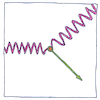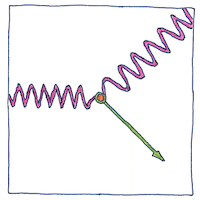Arthur Holly Compton
physics

|
Compton scattering
When a photon hits an electron, the photon transfers energy to the electron, is deflected and shifts to a lower wavelength. Arthur Holly Compton did the math in which each scattered photon hits only one electron, showing that a photon behaves as a particle, not merely as an electromagnetic wave.
Compton wavelength
A photon’s energy is directly related to its frequency. A particle’s mass is equivalent to an energy by Einstein’s formula, E = mc2. The Compton wavelength of a particle is the wavelength of a photon whose energy is equivalent to the particle’s mass. The Compton wavelength is the amplitude of the particle’s Zitterbewegung oscillation.
Inelastic scattering
When an unstoppable bullet hits an impenetrable wall, the theory disintegrates. There are no such things. Let us rephrase the problem. Our paths shouldn’t depend on which of us is the more stubborn. No bullet’s unstoppable and no wall’s impenetrable. Maybe the bullet can turn corners and maybe the wall is not complete. A little creative thinking, a little kindness and respect, more altruism and less egotism, can stretch the possibilities.



Classical electromagnetic theory predicted that X-rays would not lose energy when scattered. The effect depends on the energy of the photon relative to the energy-equivalent of an electron. Compton scattering is inelastic. It happens when the energy of the photon is higher. Thomson scattering is elastic but happens only when the energy of the photon is much less than the mass energy of the particle (when the particle’s Compton wavelength is much less than the photon’s wavelength).
At the energy of visible light, photons can knock electrons from a surface. This, called the photoelectric effect, supported the concept that energy is quantized.
See also in The book of science:
Readings in wikipedia: